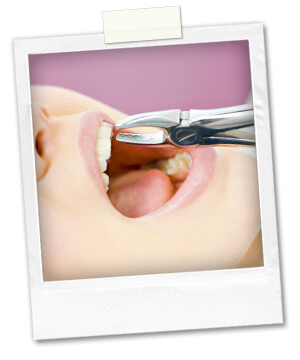Extractions

In extreme situations where recovery of the natural tooth through fillings, inlays and onlays, build-ups, crowns or root canals is not possible, it is best to extract the tooth rather than try to save it. The reason is that one bad tooth can damage your entire jaw structure as well as affect the health of your healthy teeth.
Where removal of the tooth becomes essential for the health of your jaw and other teeth from the amount of decay in the effected tooth, you have the options of bridge, dental implant, or removable partial denture as replacements.
If your baby (primary) tooth did not fall off in the required time, it has to be extracted to make way for the permanent tooth to grow. Normally the reason for delay in falling of the baby tooth can be assigned to problems in its shape or the long length of the root.
Teeth which are misaligned or impacted (Wisdom Teeth) become a source of pain or discomfort and also impact the alignment of the remaining teeth and the rest of the jaw.
The procedure for extraction is simple and does not consume much time. A local anesthesia will get you through the procedure but it would be helpful if you share your concerns or preferences concerning sedation with your dentist.
After the extraction, leaving the void unfilled can damage surrounding teeth through displacements. This will hinder chewing and cause problems with your jaw joint. In such situations, your dentist may advise you to use dental implants as replacements. Dental implants are beneficial because they are the most near to real treatment solutions and act as the natural tooth root as compared to simply bridging the gap as with Bridges. Dental implants protect surrounding teeth and discourage their movements as well as interference with proper jaw function.